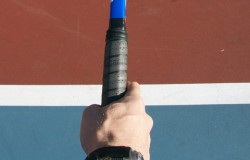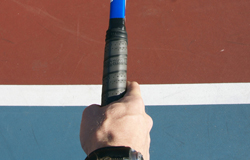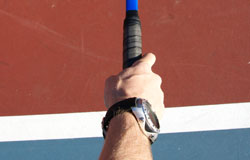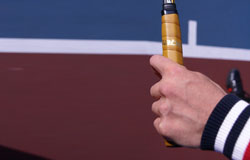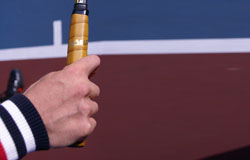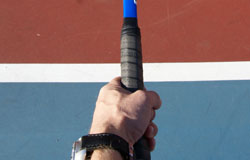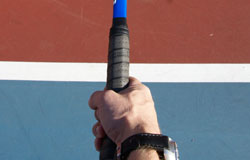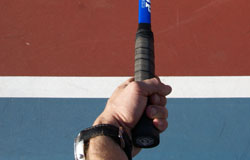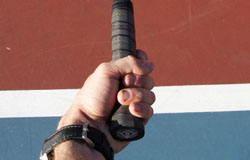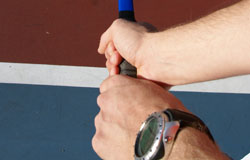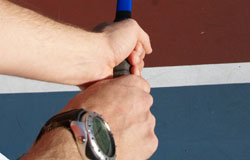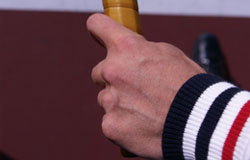1. All Tennis Grip
Make sure you don´t play with the wrong grip!
This leads to huge limitation for your development. Focus on this article so you don´t waist years of practice!
The grips sets the fundamental conditions for a proper technique and determines how the stroke is produced.
Below you will find illustrations, explanations, advantages and disadvantages of the grips we recommend.
- Continental Grip
- Serve, Continental Grip
- Serve, Midway Grip Between Continental & Eastern Backhand Grip
- Serve, Eastern Backhand Grip
- Forehand, Continental Grip
- Forehand, Eastern Grip
- Forehand, Semi Western Grip
- Forehand, Western Grip
- Two-handed Backhand, Eastern Backhand grip
- Two-handed Backhand, Continental & Mid-Semi Western grip
- One-handed Backhand, Continental Grip
- One-handed Backhand, Eastern Backhand Grip
- Volley, Continental Grip, For Beginners
- Volley, Midway Grip Between Continental & Eastern Backhand Grip, For Advanced Players
Some grips can be use to for more than one stroke, example the continental grip can be used for volleys, serves, overheads, the backhand slice and defensive shots.
_____________________________________________________________________________________________________________
-
CONTINENTAL GRIP
CONTINENTAL GRIP
Used mainly for volleys, serves, overheads, the backhand slice and defensive strokes. The continental grip can be used for both forehands and backhands, but it’s rarely used anymore for forehands, because it’s poorly suited to hitting topspin. It was a popular grip until the early 1970s, when the US Open and the Australian Open stopped playing on grass and left only Wimbledon to be dominated by the low bounces for which continental grips are best adapted.
Since the racquet face is relatively square on a continental grip, for ground strokes the strike zone is low and to the side of the body. Thats why its helpful for defensive shots, low balls, and wide balls that youre late on.
Advantages:
- Easy to handle low balls, defensive shots, and wide balls that you´re late onDisadvantages:
-One of the negatives to using this grip for your forehand is that it is very difficult to generate topspin upon the ball. I can only see one professional player playing with this grip and that is John McEnroe, he is playing with the continental grip on both the forehand and the backhand side. Another play is Stefan Edberg as also were using the continental grip on his forehand. Sometimes his hand even went over to the eastern backhand side when he was playing forehands, this is not very rare.
- Lack of consistency is often a problem -
SERVE
SERVE
CONTINENTAL GRIPFuntional grip to serve flat, slice and twisted serves
Take me to the Serve Instructions – click here
-
SERVE
SERVE
MIDWAY GRIPBETWEEN CONTINENTAL
& EASTERN BACKHAND
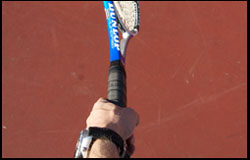
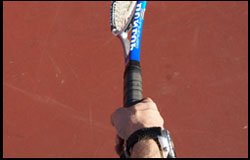
This grip is optimal for all serves:
– flat serve
– slice serve
– twisted serve
– kick serveHow To Make Twisted Serves – click here!
-
SERVE
SERVE
EASTERN BACKHAND
GRIP
This grip is optimal for one type of serve and that is the kick serve. The grip is also used to hit twisted serves but we recommend the mid-way grip for the twisted serve.
Limitations: when serving the flat and slice serve! The reasons for that: A round swing pattern becomes more natural with this grip instead of “hitting through the ball” when contact is made.
Learn The Golden Five Check Points in The Swing Path for More Power – click here!
-
FOREHAND
FOREHAND
CONTINENTAL GRIPThe more closed racquet face, the higher and farther in front of your body your strike zone should be for proper contact.
Since the racquet face is relatively square on a Continental grip, for ground strokes the strike zone is low and to the side of the body. Thats why its helpful for defensive shots, low balls and wide balls that you´re late on.
Advantages
- easy to handle low balls, defensive shots, wide balls that you´re late on also called the running forehand.Disadvantages
– one of the negatives to using this grip for your forehand is that it is very difficult to generate topspin, so lack of consistency is often a problemI can only see one professional player playing with this grip and that is John McEnroe, he is playing with the continental grip on both the forehand and the backhand. Stefan Edberg was also one player using the continental grip on his forehand and he even sometimes used the eastern backhand when he was playing forehands, this is vary rare.
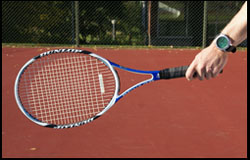
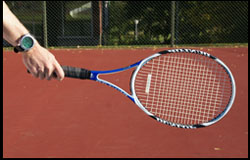
-
FOREHAND
FOREHAND
EASTERN GRIPThe Eastern forehand grip is the classic grip most often taught to beginning students, and although it has been largely displaced on the pro tours by the Semi-Western forehand grip, it is still used by many advanced players.
Advantages
- this is generally considered the easiest grip for learning the forehand
- to play flat hard forehands (no spin on the ball)
- easy to handle low balls
- and great to use when playing defence forehands
- when approaching the net no grip change is needed for volley or overheads.Disadvantages
- hard to put heavy topspin on the ball
- hard to handle high ballsPros Playing with this grip
Pete Sampras, sometimes Roger Federer. Usually Roger is using a between grip between the eastern forrhand grip and
the semi-western forehand grip. Best with this between grip is that you are able to hit both powerful forehands with
no spin and also put more spin on your forehands for safety!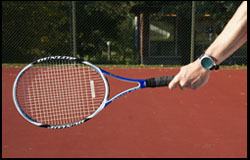

Want to Learn To Play the Modern Forehand with more Topspin?
-
FOREHAND
FOREHAND
SEMI WESTERN GRIPThe Semi-Western Forehand Grip is a fantastic grip when playing tennis! Both for men and women. The average grip among the pros is probably the Semi-Western forehand grip, primarily because of the importance of heavy topspin in the modern, advanced game.
Advantages
- easy to put heavy topspin on the ball
- shot will usually have a high and explosive bounce, the heavy topspin, pushing your opponent behind the baseline
- easy to handle high ballsDisadvantages
- hard to handle low ballsPros Playing the semi-western forehand grip:
Marat Safin, Andy Roddick, David Nalbandian

I Really Want To Start Playing With Heavy Topspin – Click Here
-
FOREHAND
FOREHAND
WESTERN GRIPThe Western Forehand Grip, it´s an extreme grip. The most natural swing pattern with a Western grip is sharply upward and very fast, which explains why most Western hitters generate heavy topspin. The Western grip handles high balls much better than low ones. Clay-court specialists and players who hit with heavy topspin favor this grip.
Advantages
- easy to put heavy topspin on the ball
- easy to handle high balls
- shot will usually have a high and explosive bounce, pushing your opponent behind the baseline
- the ability to handle high balls is what makes this grip so popular with clay-courters and juniorsDisadvantages
-hard to handle low balls
- limitation to hit powerful winners
- you need tremendous racquet-head speed and wrist strength to generate adequate pace and spin.
If not, your shots will land short and your opponents can attack them.Pros Playing the western forehand grip:
During the 90th and beginning of year 2000 several players used the western forehand grip but noadays it´s not that many, especially on the ATP-tour.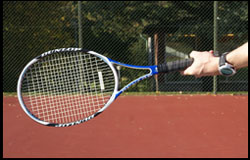
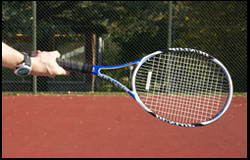
-
TWO-HANDED BACKHAND
TWO-HANDED BACKHAND
EASTERN GRIP
The Eastern Two-handed Backhand Grip
How To:
Dominant hand – eastern backhand
Non-dominant hand – semi-westernAdvantages
- easy to put heavy topspin on the ball
- easy to handle high ballsDisadvantages
- hard to handle low balls

-
TWO-HANDED BACKHAND
TWO-HANDED BACKHAND
CONTINENTAL
& MID-SEMI
WESTERN GRIP
How To:
Dominant hand - continental grip.
Non-dominant hand – mid-semi western forehand grip (something between the eastern forehand and semi-western forehand grip)Take your non-dominant hand and put it above your playing hand in a mid-semi-Western forehand grip. A two-handed backhand is a lot like a forehand with your non-dominant arm, so if you’re used to a Semi-Western grip on your forehand, you might want to use it for your non-dominant hand like Nadal does.
Advantages
- this is an excellent choice for players who aren´t strong enough to hit a one-handed backhand
- easy to provide power
- A more compact stroke than the one-hander, the two-hander relies on shoulder rotation and an efficient swing to provide power.
Thats why its particularly effective on the return of serve.
- It´s also good on low shots, and the extra arm lets you power through on balls that are at shoulder level.Disadvantages
- because both hands are on the racquet, the two-hander limits a players reach
- difficult to rotate your upper body when stretched.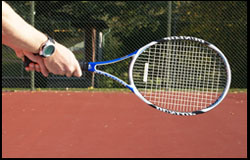
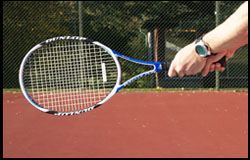
Take Me To “The Bible of the Two-handed Backhand” – Click Here
-
ONE-HANDED BACKHAND
ONE-HANDED BACKHAND
CONTINENTAL GRIPAdvantages
- Great for beginnersDisadvantages
- hard to play with heavy topspin
- hard to play on high ballsOne can hit with consistency and some topspin with a Continental backhand grip move on to the one handed eastern backhand grip, see below


-
ONE-HANDED BACKHAND
ONE-HANDED BACKHAND
EASTERN
BACKHAND GRIP


-
VOLLEY
VOLLEYCONTINENTAL GRIP
For Beginners
The volley is an essential shot for every good tennis player because it allows you to end the point at the net. When you come to net, you are trying to put the ball away and not have a long rally. If you can master the fundamentals presented here, you will be well on your way to hitting technically correct, effective volleys. Rembember, you are at net, you don’t have enough time to switch your grip, therefore, use the same grip for both the forehand and backhand volley.
-
VOLLEY
VOLLEY
MIDWAY GRIP
BETWEEN CONTINENTAL
& EASTERN BACKHAND
For Advanced Players
When mastering the volley with this secreat grip you going to be king or queen of the court! This is the same grip as the best volley player used during his whole carrer. The man I´m talking about is of course Stefan Edberg. With this grip you will be able to hit the first volley with sidespin, get a better feeling for low volley and a whole new movement at the net. You will have a chance to develop you footwork and move like a panter, why not give it a try?
16 (8 FH & 8 BH) Volley Lessons are waiting for you here!


